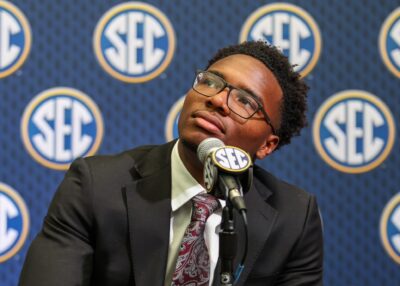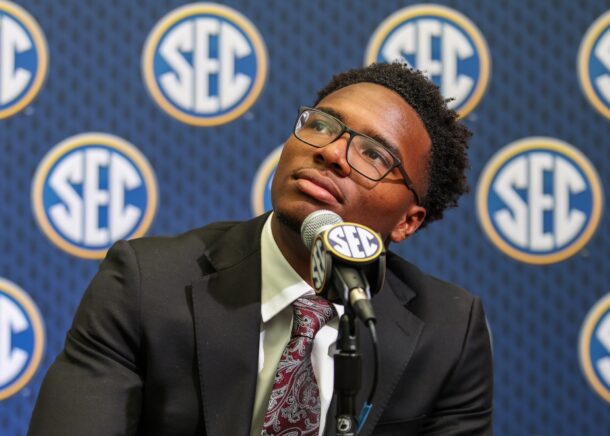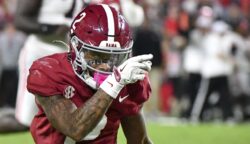The script sounds familiar: win an SEC East title, lose key starters (left tackle, top three receivers, starting defensive ends, best player in the secondary), get counted out of the division race prematurely.
How’d that work out last time?
Oh yeah, Missouri finished 7-1 in the SEC and 11-3 overall, winning another post-New Year’s bowl game.
There’s at least one major difference between this offseason and last offseason, though. The 2013 Missouri team wasn’t a national championship caliber team, but it was darned close. It earned every bit of its Top 5 ranking. Players like Shane Ray, Markus Golden, Michael Scherer, Bud Sasser and Russell Hansbrough were backups.
Maybe not three deep, but that Missouri team had two-deep talent comparable to the best in the SEC. The 2014 Tigers, however, played with a noticeable lack of depth.
The SEC East should be fairly tame for one more year, with Tennessee still climbing, Florida turning the ship around and South Carolina trying to avoid permanent regression. Next year’s schedule is very manageable. Will this team be as equipped as last year’s to transition to another season?
Here are five things the team can do to improve its outlook in the future.
1. Recruit more four- and five-star players
Missouri coach Gary Pinkel has a well-earned reputation for developing talent, something he trumpeted at SEC Media Days in July.
Call it “Mizzou Made.” Call it placing a premium on raw athletes yet to reach their potential. Acknowledge all you want that the Tigers do it differently, and that it works for them.
That’s great.
But imagine how far that same ability to develop talent would take the team if the initial materials are world-class diamonds and gold rather than aluminum and steel.
Missouri’s athletic program doesn’t have the resources of an Alabama or LSU, but back-to-back SEC East championships and a strong recent history of sending talent to the NFL ought to be enough to leverage more than three four-star recruits in the 2015 class, which is where the Tigers sit now.
If James Franklin can do it at Vanderbilt and Jim Harbaugh could do it at Stanford, Pinkel and the Tigers should be able to do it in Columbia. We’re not talking Top 10 classes every year, but there’s no reason the team can’t muster a few Top 25s.
2. Improve the facilities
The reality of college football in 2015 is that it’s a business driven by tens of millions of dollars for coaches, and, yes, facilities.
The $46.5 million expansion to the east side of Faurot Field, completed before the 2014 season, and the new indoor facilities and office space already approved by the Board of Curators are important steps.
I’ll let Pinkel take it from here, with quotes from a Columbia Tribune story earlier this year:
“The next thing we have to do — and we have to do it fast, OK? We have to do it in the next few years — we have to build a facility down there in the south that wraps around there. And it’ll have football offices, weight room, new locker room. Our offices are nice but, compared to everybody else in the league, they’re just average. We don’t want to be average at anything. We need to build that down there at the south end, and we don’t need to wait six to eight years to get it done.
“We want to win at a high level, we want to compete at a high level. We want to try and be the best we can be. Facility-wise, that’s what we have to get done. That’s the next project in my rallying squad. Things we need to get done.”
Athletic director Mike Alden in June put the onus on the fans, hinting that he’d prefer to hold off until the team starts selling out its seats for football games. But like Pinkel said in his strong public statements, it’s hard to compete in recruiting and from a business sense if the program lags behind with sub-par facilities.
3. Create a better version of Maty Mauk
Let’s not get crazy with the comparisons, as some did before the 2014 season. Mauk is no Johnny Manziel.
He does have the ability to keep plays alive with his athleticism, a flair for improvisation and a gunslinger mentality. But there were all sorts of issues that prevented Mauk from playing at or close to an All-SEC level as a sophomore.
First, Mauk needs to become at least adequate and somewhat comfortable operating from within the pocket. He started hearing footsteps during the middle part of the season, bailing early and often. Sometimes that sort of improvisation can turn nothing into something, but other times it works in the opposite direction.
As athletic as Mauk is, he wasn’t nearly the runner of a Dak Prescott or even a James Franklin. He flashed in this area at times. When nothing is open downfield, he needs to learn to either tuck and run, using his physical tools to pick up positive yardage, or throw the ball out of bounds. Too often he tries to force long throws into coverage, which backfired too many times in 2014.
Against certain defenses, Mauk at times struggled to spot linebackers or defensive backs in zone coverage, throwing to a receiver or tight end he saw as open only for the defender to “appear” in the throwing lane. Learning to read defenses takes time, and for Missouri’s sake, hopefully Mauk logs some hours developing that ability this offseason.
The talent is there and Mauk is still young, but he now has a season and a half of SEC football behind him. It’s time he helps carry this team like many expected of him in 2014.
4. Find someone (or a few someones) to catch the football
One of the reasons Mauk should be under so much pressure this offseason is that the team lost its top three receivers for a second consecutive year.
Only last season, the three new starters were relatively experienced and pretty talented.
Look at the numbers: the pass-catchers behind Bud Sasser, Jimmie Hunt and Darius White produced next-to-nothing. It would’ve been nice to see a few of them flash during their “get your feet wet” opportunities, but luckily, there are plenty of young, physically-talented players at the position.
Will this offseason be enough time for the group to develop into a decent receiving corps for the 2015 season?
5. Evolve on defense to account for the departures of Shane Ray and Markus Golden
It’s unfair to expect Marcus Loud and Charles Harris to approximate the edge rush Missouri enjoyed the last two years. But the Tigers can continue to field a strong defense by evolving.
The interior should take a starring role in 2015, with a trio of proven, athletic defensive tackles and what should be two very good linebackers behind them in Scherer and Kentrell Brothers.
But in addition to developing the young pass rushers, Missouri has to get much better in the secondary. Braylon Webb is gone from a group that performed just OK in 2014, helped by a monster pass rush. Players like Aarion Penton and John Gibson must get better, or teams will have an easier time throwing downfield on Mizzou in the fall.
An itinerant journalist, Christopher has moved between states 11 times in seven years. Formally an injury-prone Division I 800-meter specialist, he now wanders the Rockies in search of high peaks.







